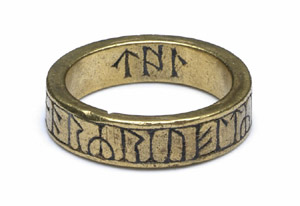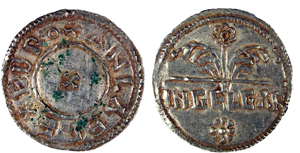|
There is
a golden ring with mysterious Runes carved on it that was discovered in
Cumbria in 1817 and bears uncanny echoes of JRR Tolkien's Lord of the
Rings. While the ring that both Frodo and Gollum wanted to possess had
known powers, the secrets of the Cumbrian ring have so far not been fully
decoded. The gold ring known as the Kingmoor ring, is a 10th – 12th
century finger ring, bearing a magical runic inscription which may be
designed to ward off fever and leprosy, but an exact translation of the
Runes has never been managed.
The Cumbrian ring was found at Kingmoor and by 1859 the ring was in the
possession of the British Museum. However a perfect replica copy is kept
at Carlisle's Tullie House museum. There is an entry charge of £5.20
to visit the museum and the replica ring is on display in the archeological
collection. The area at Greymoor Hill where the ring was found is now
known as the Kingmoor Nature Reserve.
Cumbria has strong ties to our Viking past with place names, Viking gravestones
and crosses and the DNA record of ancestry showing there are hints of
Viking blood flowing in some West Cumbrian veins!
 J.R.R.
Tolkien, author of Lord of The Rings was an expert in Old English and
Viking Runes and a university professor of Anglo-Saxon history at Oxford. J.R.R.
Tolkien, author of Lord of The Rings was an expert in Old English and
Viking Runes and a university professor of Anglo-Saxon history at Oxford.
His undoubted involvement with archaeological discoveries and knowledge
of runic rings and amulets, played a large part in his epic creation,
the superb stories that gained movie success. The Lord of the Ring trilogy
was written in stages during the dark days World War II.
The story that fascinates adults and children alike, hinges around the
rings of Power which were crafted by the Elven-smiths. But Sauron, the
Dark Lord, forged the One Ring in Mordor, filling it with his own power
so that he could rule all others. This was the ring that we all know as
My Precious from the well known story. There has been statements that
the Kingmoor Ring is not a Viking-ring but an Anglo-Saxon one inscribed
with English runes.
The Cumbrian
ring is one of a small number of Viking Age rings with inscriptions, others
being the Bramham Moor, Coquet Island, Cramond, Linstock Castle and Wheatley
Hill rings.
The Cumbrian inscription is undeciphered and has a total of 30 Runes.
The story of the Cumbrian ring was the subject of an original article
”Magic Ring of Kingmoor“, written by Keeper of Archaeology at
Carlisle, Mr. Tim Padley.
Mr Padley told the Guides that the ring was found by navies digging in
the fences for the new railway that was being built through Carlisle.
He said of the Runes on the ring, "the Runes seem slightly garbled
and it is unclear what their real message is."
The website, Omniglot, about all the world's languages has a page on Runes
at http://www.omniglot.com/writing/runic.htm
Another Viking Cumbrian Connection as Coin Hoard is found
by metal detector

The find by a metal detector enthusiast indisputably links the Furness
and West Cumbria area with Norse. The find dates from a time when England
was meant to have been unified under King Athelstan, which according to
history occurred after a gathering of the English Kings at Eamont Bridge,
Penrith on the 12th July, AD 927. The hoard itself was discovered in Easter
this year by a locally-based metal detectorist, who unearthed the 92 pieces
made up of a number of very rare silver coins and other assorted artefacts
which are being examined by the academics at the British Museum in London
who are set to reveal their findings in December. There is a hope to eventually
house the hoard at the Dock Museum in Barrow.The Viking links are further
validated by several significant Viking monuments of worldwide reputation
found in Cumbria , particularly the Norse Cross, found in the graveyard
at St Mary's Church, Gosforth, which is the tallest in England at 14ft
in height, and depicts the victory of Christ over the pagan gods.
|
|

